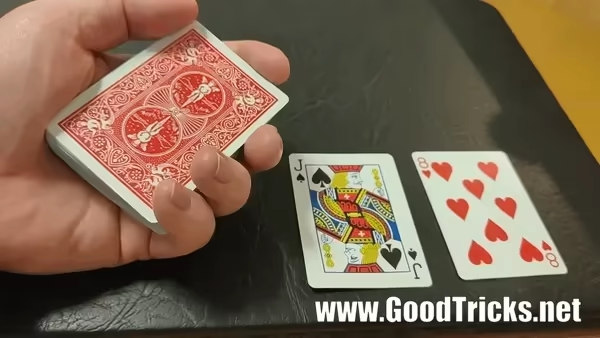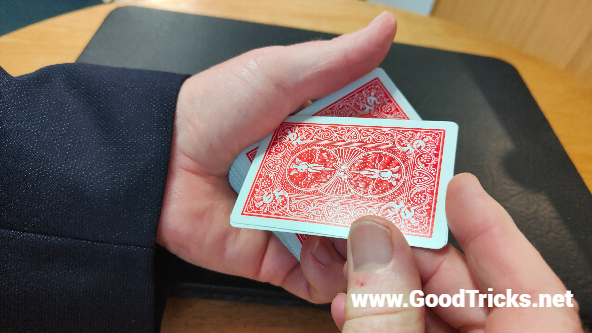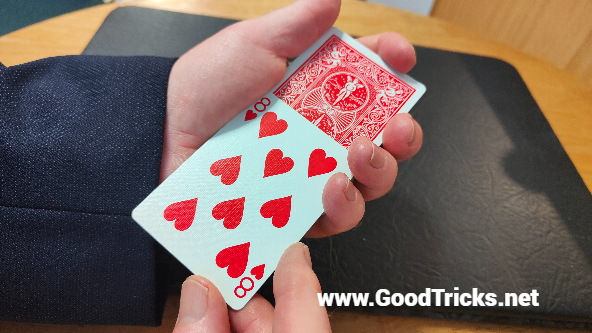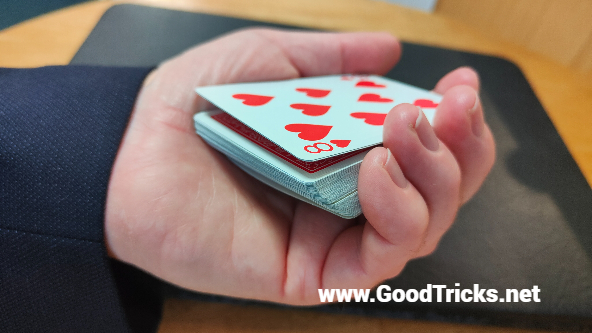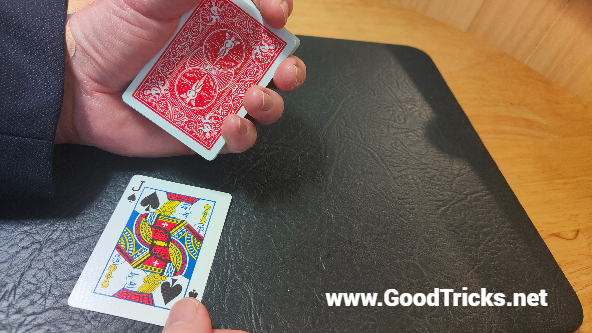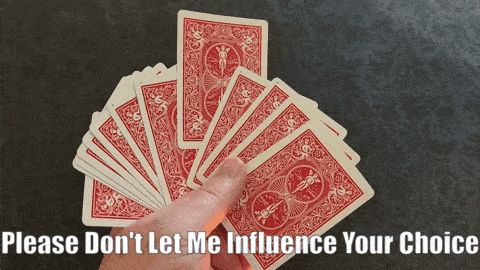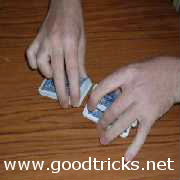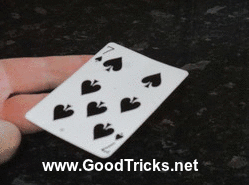Card Trick Sleights And Sleight Of Hand
Card sleights including the double lift are very useful moves used to assist a magician to perform a card trick. The noun sleight refers to cunning or cleverness so together with a little misdirection these moves can help a trick achieve a very powerful effect.
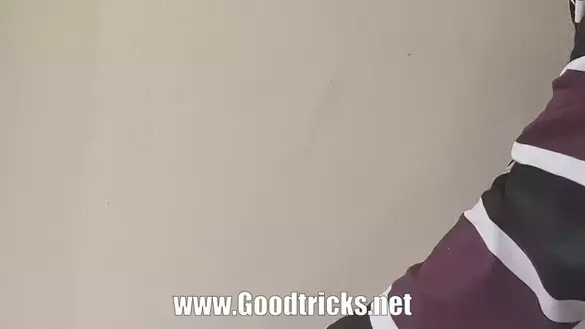
Some sleights require greater hand dexterity than others but this page shows the workings of a few popular easy ones that when combined with a little practice will help you to achieve some spectacular magic effects.
Double Lift
To do the double lift is the art of appearing to lift only the top card off from the pack when in reality, you are lifting the top two cards as one.
When this is done with the correct blend of finesse, showmanship and a little sprinkling of misdirection, you have all the ingredients you need for the ultimate deception.
This little card manipulation will open the door to hundreds of seemingly impossible magic tricks that you can use to astonish and impress.
Here is a Slo Mo example with super exaggerated moves for demonstration purposes.
You can see a basic example of the two card push off version in action above here. A break down of the set up and performance of the move are explained step by step in the photos below here.
In this example we will use the 8 of hearts.
To prepare the deck before carrying out this excellent sleight, make sure that the card that you wish to manipulate is second from the top. In our example we will use the eight of hearts. The actual top card is in reality, the Jack of spades.
The cards should be held as shown in a basic hold known as the mechanic's grip to keep them in place and to help ensure that your spectator does not get a chance to peek a glance and discover that there are actually two cards being lifted.
You then proceed to push of two cards with the side of your thumb. This is done by applying slight pressure to the deck with the thumb and also using your three fingers on the lengthwise side of the cards to slightly lower and allow two cards to pass over them.
Don't worry if three or more cards push over. Just pinch the top two, with your other hand as shown and use your grabbing fingers to push the extra cards back into the deck.
The secret to a smooth transition is as follows. Hold the top right corner of the two cards as shown in the above photo with your first finger on the top edge and thumb on the lengthwise edge.
You can use your middle finger to apply slight upward pressure to the underside of the card.
This, together with pushing the two cards gently onto the fleshy part at the base of your thumb, will allow you to pivot the cards around and then let them fall face side up onto the deck.
The two cards can then be pushed up until they are in line with the rest of the deck.
The gripping position of your hand, holding the deck will ensure that the cards can be glided securely into place using your fingers on one side and thumb base on the other as guide rails, safely without them being seen as two cards.
.
During this sliding action, it is useful to maintain a slight pinky break below the two cards to make picking them up together, easier.
The two cards should then be pinched in a similar manner as before with first finger and thumb to keep them together.
The gripped cards should then be flipped up and over until they fall face down back onto the pack.
Your other thumb in the hand thats holding the deck, can be used to help guide the cards flush across the deck as shown above.
The two cards are again squared up with the rest of the pack as before and then the top card is upturned to show that it has miraculously changed from the eight of hearts into another card ???
You now have the secret to one of the most valuable and widely used sleights in magic.
Although it appears relatively simple, it is vital to make sure that it is practiced until you can perform it smoothly.
This can really help to reinforce the memorable impression that a trick has on someone.
The move can be incorporated into thousands of routines, one of the most famous being the ambitious card routine, where a card is inserted into the middle of the deck but keeps jumping back to the top.
How To Palm A Card
|
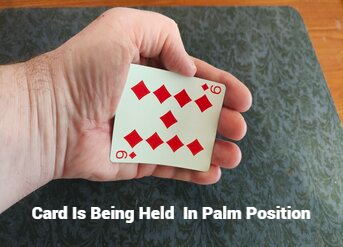 |
The deck should be held as demonstrated in Photo:1 shown below.
Using your other free hand, bring your palm face down over the pack of cards, cradling them so it looks like you are merely just squaring up the deck. Take care to keep the fingers and thumb of your free hand closely together and gently squeeze the top card so that its top edge is pressing against the first joint of your fingers and the bottom corner is wedged against the fleshy base of your thumb. Photo:2
Keeping fingers and thumb close together, keep a slight bend on the card and stealthily remove your hand away from the spectators view. Photo:3
As long as the palm of the hand is not in view , this sleight will look completely natural and unsuspicious as it is not in an obvious gripping position or clenched fist.
 |
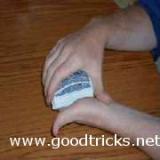 |
 |
Photo 1 |
Photo 2 |
Photo 3 |
Easy Methods Of Forcing a Card
To"force a card" is to ask the spectator to choose any card and make them pick the card you want them to pick, while leaving them thinking that they had a completely free choice.
This way, you can create your own tricks. Just before performing your trick, select a card to force. Then, force that card on your spectator, let them view the card without you seeing it and then re insert it back in the deck.
Very Useful Ways To Force A Card : Being able to do a convincing card force is one of the most useful and most used basic skills in magic. It is important to be competent and have at least a couple of ways to perform one. The video below here will clearly show you 5 of the best methods.
Cross Cut Force : ( This is an easy method of forcing a card. There are many other forces to learn as well as these.)
Shuffle the pack of cards and sneak a peek of the bottom card.( Photo:1 )
Ask your spectator to cut the pack in two and to place the half that they have cut, face down on the table. ( Photo:2 )
Take the other half of the pack of cards and place it on top of the spectator's half at a 90 degree angle to form a cross. ( Photo3 )
 |
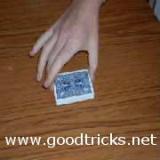 |
 |
Photo 1 |
Photo 2 |
Photo 3 |
Use a little entertaining chat or make a funny comment to momentarily distract the spectator from the set up of the cards. This should ensure that they lose track of which one of the two piles was their one.
Now ask them to pick up the top half of the deck of cards, tell them to look at the bottom one of that pile and and memorize this as their chosen card.
They can then put the two half packs back together and shuffle the cards. The card they have just memorized is the one that you took a peek at before on the bottom of the pack while shuffling.
They should have convinced themselves that they have had a free choice in cutting the cards at this point while the real truth is that the card has been "forced" upon them.
The pack is held in the dealing position. It's a good idea to slightly bevel the pack towards the outer fingers. This creates a slight edge and makes it easier for the pinky to feel and count down through the cards, the pinky tip is pressed slightly into the pack which creates a small break in the cards above and below the pinky tip. The opposite end of the pack (nearest to spectator) should be held slightly higher than the end nearest you to conceal the break.
Also at the end of the pack nearest the spectator, the edge of the top card should be firmly pressed onto the next card down with your thumb to camouflage the break. If the selected card is to be presented to audience, flip over the cards above the pinky break as shown in figure 3, using the thumb to help the move. The selected card should then fall face up on top of the deck. Maintain the pinky break and repeat the flip to return the cards to their original position.
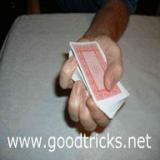 |
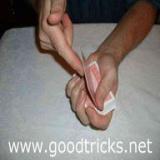 |
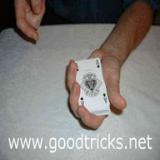 |
Photo 1 |
Photo 2 |
Photo 3 |
Do A Riffle Shuffle
If the bottom cards are to be kept in position then they are allowed to fall from the left hand in the first movement of the shuffle.
The deck is split into two packets, the ends put together, the cards being bent upwards and released in such a way that they become interlaced.
To keep a card or a small number of cards on the top of the pack, you have simply to release it or them from the right hand portion of cards, last of all.
Card Vanish And Production
A card is presented in the magician's hand and vanishes right in front of your eyes. Even more amazing, is that the card appears again as quickly as it disappeared. This move requires a lot of practice but can be incorporated into many card tricks and your practice in perfecting the move will be well rewarded with smoother showmanship. The video below shows the performance and the secret.
Easy Card Change
This video shows a convincing card change with the use of a simple slide trick.
You can learn about card sleights secrets by viewing some good quality learning card tricks DVD's which are a good way to learn card sleights by watching close up videos of professional hands performing popular sleights, accompanied by a clear explanation which are available from most good magic shops.
How To Spin A Card
Being able to spin a card in your hands looks really impressive.
This link will take you to our magic tutorial page to learn the basics of this amazing stunt.
This link demonstrates How to control a card to the top of the deck which is a useful sleight to know as it can be used in many cool routines.
Or why not use the spread cull to control a card to the bottom of the deck.
A good book for learning card magic is The Royal Road to Card Magic which is a card magic classic and a valuable learning aid.
Conclusion
The above are just a few of the many sleights that can be used to take your shows and displays of manual dexterity to the next level.
To summarise, a sleight is just a little manipulation tool, used to make an impossible feat, actually possible i.e. you appear to have defied reasonable logic to pull off a truly impressive act of prestidigitation.
Go on and practice using these useful tools now and reap the rewards of your efforts.
Back To Main Card Magic Menu

